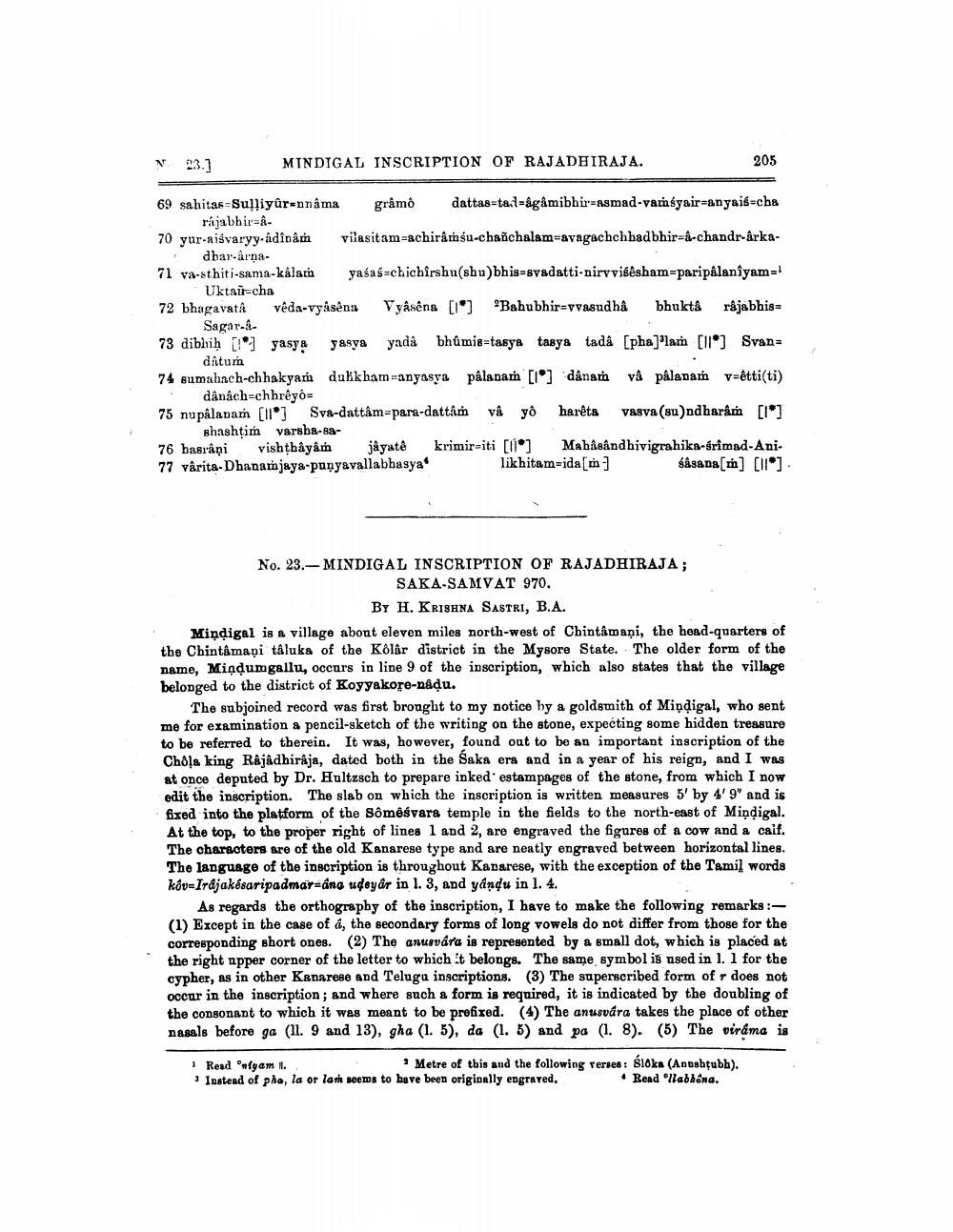________________
N03.]
MINDIGAL INSCRIPTION OF RAJADHIRAJA.
205
69 sahitas Sulliyûrænnâma grâmô dattas-tac-ågåmibhir-asmad-vamsyair=anyais-cha
rajabhir=&70 yur-aišvaryy.adina vilasitam-achirâmśu-chanchalam-avagachchbadbhir-&-chandr-arka
dbar-arna71 va-sthiti-sama-kålar yasas-chichirshu(shu)bhis=svadatti-niryvißêsham=paripälaniyam=1
Uktair-cha 72 bhagavata veda-vyåsena Vyâsena [*] Bahubhir=vvasudha bhukta rajabhis
Sagar-a73 dibhiḥ 01 yasy: yasya yada bhůmis-tasya tasya tada [pha]"lam [11*] Svan
datum 74 gumahach-chhakyam dulkham-anyasya pâlanam [lo] dânam và pålanam v=étti(ti)
dânấch-chorry0= 75 nupâlapar (ll] Sva-dattam-para-dattam và yê harêta vasva (sundharam [1]
shashtim varsba-sa76 baBrấại vinhthâyẩm jayate krimir-iti [11] Mahâsândhivigrahika-Srimad-Ani. 77 vârita-Dhanamjaya-punyavallabhasya
likhitam=ida[m] sâsana[m] [118]
No. 23.-- MINDIGAL INSCRIPTION OF RAJADHIRAJA;
SAKA-SAMVAT 970.
BY H. KRISHNA SASTRI, B.A. Miņdigal is a village about eleven miles north-west of Chintamani, the head-quarters of the Chintamaņi tâluks of the Kolar district in the Mysore State. The older form of the name, Mindungallu, occurs in line 9 of the inscription, which also states that the village belonged to the district of Koyyakoro-nadu.
The subjoined record was first brought to my notice hy a goldsmith of Mipdigal, who sent me for examination a pencil-sketch of the writing on the stone, expecting some hidden treasure to be referred to therein. It was, however, found out to be an important inscription of the Chôļa king Rajadhiraja, dated both in the Saka era and in a year of his reign, and I was at once deputed by Dr. Hultzsch to prepare inked estampages of the stone, from which I now edit the inscription. The slab on which the inscription is written measures 5' by 4'9" and is fixed into the platform of the Sômêśvara temple in the fields to the north-east of Mindigal. At the top, to the proper right of lines 1 and 2, are engraved the figures of a cow and a caif. The characters are of the old Kanarese type and are neatly engraved between horizontal lines. The language of the inscription is throughout Kanarese, with the exception of the Tamil words kôv=Irdjakéaripadmar=ang udeyar in l. 3, and yandu in l. 4.
As regards the orthography of the inscription, I have to make the following remarks :(1) Except in the case of a, the secondary forms of long vowels do not differ from those for the corresponding short ones. (2) The anusvára is represented by a small dot, which is placed at the right upper corner of the letter to which it belongs. The same symbol is used in 1.1 for the cypher, as in other Kanarese and Teluga inscriptions. (3) The superscribed form of r does not occur in the inscription; and where such a form is required, it is indicated by the doubling of the consonant to which it was meant to be prefixed. (4) The anusvára takes the place of other nasals before ga (11. 9 and 13), gha (1. 5), da (1. 5) and pa (1. 8). (5) The viráma is
1 Read Ongam Il.
Metre of this and the following rerses: śloka (Anushțubh). Instead of pha, la or lan seems to have been originally engraved.
• Read Nabhóna.




